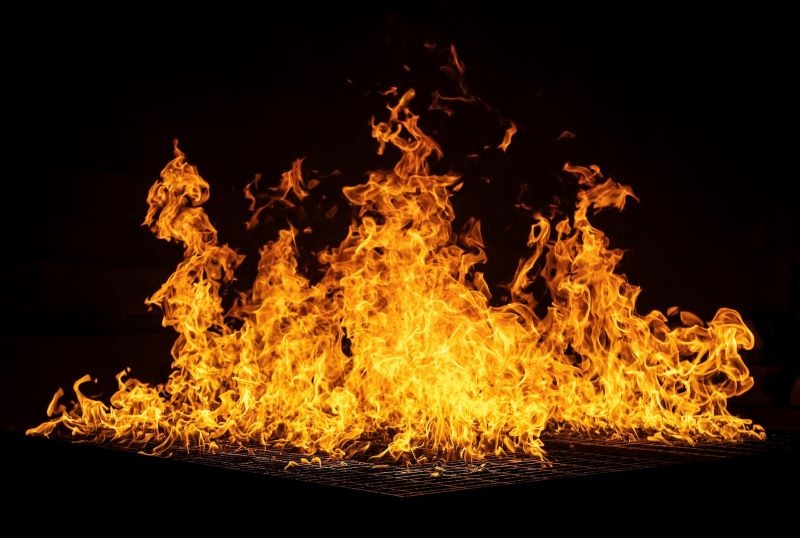Did you know that of the nearly 5,000,000 cooking fires that occur in homes, grease fires are the most dangerous? That’s right—grease fires are the most volatile and account for one in every five home fire deaths. As a homeowner, landlord, or Airbnb host, understanding how to prevent and put out a grease fire is crucial for the safety of your tenants and guests.
In this article, we’ll be taking a closer look at the measures and strategies for putting out grease fires. Read on to learn how to handle these fires efficiently and save your property and loved ones from their devastating effects.
How do grease fires start?
When cooking oil becomes overheated and ignites, it can cause a dangerous grease fire. Both vegetable oil and animal-based fats are prone to fire, with vegetable oil reaching a scorching 450 degrees. It’s important to remember that these oils can quickly reach those temperatures, catching you off guard.
Other causes of kitchen fires include adding frozen food to hot oil, overheating the oil too quickly, splashing grease-filled pans into a heated oven, or leaving the stove unattended.
What to do in case of a grease fire
When it comes to dealing with a grease fire, it’s crucial to remember never to use water. Pouring water on a grease fire can make things worse since water and oil don’t mix, and it can cause splashes that spread the fire further. Instead, follow these steps to put out the fire safely:
1. Turn off the heat source immediately
The first step to take when dealing with a grease fire is to turn off the heat source, whether it’s a stove or an oven. By doing so, you can cut off the fuel supply to the fire, which will prevent it from spreading.
2. Smother the flames with a pot lid or baking pan
If the fire is small, you can use a pot lid or baking pan to smother the flames. Covering the fire with a metal lid or pan will help remove oxygen, which is needed for the fire to burn, and cause the fire to go out on its own.
3. Use salt or baking soda
Salt or baking soda can also help to extinguish a grease fire. However, it’s important to make sure that you’re using the correct product, as similar-looking powders like flour, sugar, and baking powder can make the fire worse.
4. Use a Class K or B fire extinguisher
In the event that the fire becomes too large to extinguish with baking soda or salt, it’s time to reach for the fire extinguisher. The best type of fire extinguisher for a grease fire is Class K, which is specially designed for cooking fires. The Class K extinguisher produces a foamy solution that smothers the fire by interrupting the air supply and reducing the temperature of the flames.
Note: If you don’t have a Class K extinguisher, a Class B extinguisher that uses dry chemicals can also be an effective alternative. However, it’s essential to remember never to use a Class A-only fire extinguisher on a grease fire as it contains water, which can make the fire worse.
How to prevent a grease fire
Preventing grease fires in the kitchen is key to ensuring everyone’s safety. As the saying goes, an ounce of prevention is worth a pound of cure. Consider taking the following steps to minimize the chance of fire:
- Do not leave your pot or pan unattended since it is the primary cause of kitchen fires.
- Slowly heat the oil to avoid overheating and splattering.
- When adding food to hot oil, add it gradually and gently to prevent splattering.
- Stay alert around the fire, avoid cooking when tired or intoxicated, and pay attention.
- Before cooking, remove as much moisture as possible from food and avoid placing frozen food into hot grease.
- Keep baking soda or salt nearby to extinguish flames if necessary.
- Store cookie sheets near the stove but not underneath since they won’t be helpful if that area is inaccessible.
- Keep a metal pot lid on the counter, ready to use in case of a pot fire.
- Keep oven mitts, utensils, and other flammable things away from the stovetop.
- Monitor the grease to maintain it at the recommended temperature using a thermometer.
Remember to check your smoke detectors regularly and have a plan ready in case of a fire. By being cautious and prepared, you can reduce the risk of a grease fire and keep your kitchen safe.
What to do in the worst-case scenario?
In case the prevention measures don’t work and a grease fire does occur, it’s important to know how to react quickly and safely.
First, call 911 and evacuate from the site of the fire. Then, contact a Utah fire restoration company to assist with the cleanup and restoration process. Professionals have the expertise and equipment to repair structural damage, remove smoke and soot, and salvage belongings.
While waiting for the restoration team, limit movement within the house to avoid further damage and change the HVAC filter to prevent smoke and soot spread. Do not attempt to clean anything yourself.
After the restoration process, document all work done to file an insurance claim and prevent future fires by installing smoke detectors and keeping a fire extinguisher on hand.
Dealing with fire or smoke damage can be challenging, but a professional Utah fire restoration company can help you recover and return to living in your home quickly.

